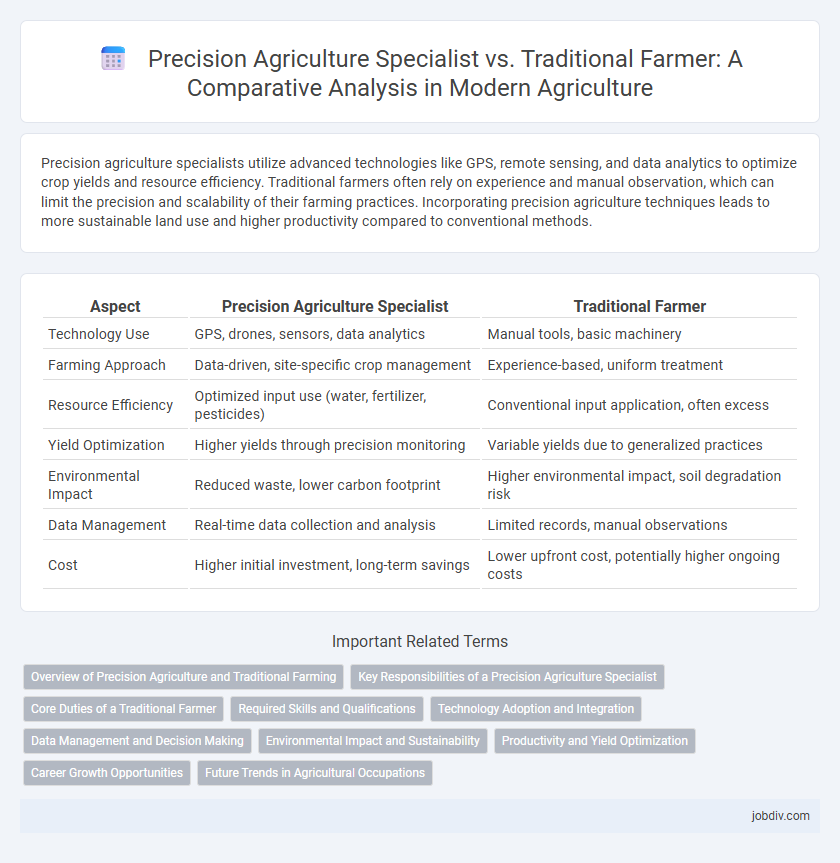Precision agriculture specialists utilize advanced technologies like GPS, remote sensing, and data analytics to optimize crop yields and resource efficiency. Traditional farmers often rely on experience and manual observation, which can limit the precision and scalability of their farming practices. Incorporating precision agriculture techniques leads to more sustainable land use and higher productivity compared to conventional methods.
Table of Comparison
| Aspect | Precision Agriculture Specialist | Traditional Farmer |
|---|---|---|
| Technology Use | GPS, drones, sensors, data analytics | Manual tools, basic machinery |
| Farming Approach | Data-driven, site-specific crop management | Experience-based, uniform treatment |
| Resource Efficiency | Optimized input use (water, fertilizer, pesticides) | Conventional input application, often excess |
| Yield Optimization | Higher yields through precision monitoring | Variable yields due to generalized practices |
| Environmental Impact | Reduced waste, lower carbon footprint | Higher environmental impact, soil degradation risk |
| Data Management | Real-time data collection and analysis | Limited records, manual observations |
| Cost | Higher initial investment, long-term savings | Lower upfront cost, potentially higher ongoing costs |
Overview of Precision Agriculture and Traditional Farming
Precision agriculture utilizes GPS technology, drones, and data analytics to optimize crop yields, reduce resource use, and enhance farm management efficiency. Traditional farming relies on manual labor, basic machinery, and empirical knowledge, often resulting in less precise input application and lower productivity. Adopting precision agriculture techniques leads to improved soil health, water conservation, and increased profitability compared to conventional farming methods.
Key Responsibilities of a Precision Agriculture Specialist
A Precision Agriculture Specialist leverages advanced technologies such as GPS mapping, remote sensing, and data analytics to optimize crop yields and resource management. Their key responsibilities include analyzing soil and crop data to create targeted treatment plans, implementing IoT-enabled equipment for real-time monitoring, and developing strategies for sustainable farming practices. This data-driven approach enhances efficiency and reduces environmental impact compared to traditional farming methods.
Core Duties of a Traditional Farmer
Traditional farmers focus on manual crop cultivation, soil preparation, and livestock management using time-tested methods. Their core duties include planting, irrigation, pest control, and harvesting based on seasonal cycles and environmental observations. They rely on hands-on experience and conventional tools rather than digital technology or data analytics.
Required Skills and Qualifications
Precision Agriculture Specialists require expertise in data analysis, GPS technology, and remote sensing to optimize crop yields, whereas Traditional Farmers rely more on hands-on experience and practical knowledge of soil, weather patterns, and crop management. Specialists often hold degrees in agricultural science, agronomy, or engineering, while Traditional Farmers typically develop their skills through generations and on-field practice. Mastery of digital tools and precision equipment distinguishes specialists from the traditional approach centered on observational farming techniques.
Technology Adoption and Integration
Precision Agriculture Specialists leverage advanced technologies such as GPS-guided equipment, drone surveillance, and data analytics platforms to optimize crop yields and resource management, significantly outperforming Traditional Farmers who rely primarily on manual observation and conventional farming methods. The integration of IoT sensors and real-time data enables precise monitoring of soil health, moisture levels, and pest activity, facilitating proactive decision-making and sustainable practices. Technology adoption in precision agriculture enhances efficiency, reduces input costs, and promotes environmental stewardship compared to the limited technological integration in traditional farming.
Data Management and Decision Making
A Precision Agriculture Specialist leverages advanced data management tools such as GPS, IoT sensors, and satellite imagery to collect real-time crop and soil information, enabling precise and informed decision making. In contrast, Traditional Farmers primarily rely on experience and observational techniques, often using manual record-keeping and localized knowledge, which can limit the accuracy and timeliness of agricultural decisions. The integration of big data analytics and machine learning in precision agriculture enhances crop yield predictions and resource optimization, surpassing traditional methods in efficiency and sustainability.
Environmental Impact and Sustainability
Precision Agriculture Specialists utilize satellite imagery, GPS technology, and data analytics to minimize chemical use and water waste, significantly reducing soil degradation and runoff compared to Traditional Farmers. By implementing variable rate technology and real-time monitoring, they enhance crop yields while promoting sustainable land management practices that protect biodiversity and reduce greenhouse gas emissions. Traditional farming methods often rely on uniform input applications and manual monitoring, which can lead to overuse of resources and increased environmental footprints.
Productivity and Yield Optimization
Precision Agriculture Specialists leverage advanced technologies such as GPS-guided equipment, drones, and soil sensors to optimize crop management, resulting in significantly higher productivity and yield compared to Traditional Farmers who rely on conventional methods. Data-driven decision-making enables precise input application, reducing waste and enhancing plant health, while Traditional Farmers often face challenges in maximizing output due to uniform treatment of variable field conditions. This technological integration in precision agriculture leads to improved resource efficiency, increased crop yields by up to 20-30%, and sustainable farming practices that outperform traditional approaches.
Career Growth Opportunities
Precision Agriculture Specialists benefit from advanced technology integration and data analytics, leading to enhanced decision-making and higher efficiency in crop management. Traditional Farmers rely on experiential knowledge and manual methods, which may limit scalability and modernization opportunities. Career growth in precision agriculture offers pathways in agritech innovation, sustainable farming solutions, and digital agriculture consultancy, expanding professional prospects beyond conventional farming roles.
Future Trends in Agricultural Occupations
Precision Agriculture Specialists utilize advanced technologies such as GPS mapping, IoT sensors, and data analytics to optimize crop yields and resource efficiency, contrasting with Traditional Farmers who rely on manual practices and experience-based decisions. Future trends indicate a growing demand for specialists skilled in AI-driven farming, drone monitoring, and sustainable agriculture techniques to address climate change and global food security. Automation, big data analysis, and smart irrigation systems will redefine agricultural occupations, emphasizing technology integration over conventional labor-intensive methods.
Precision Agriculture Specialist vs Traditional Farmer Infographic

 jobdiv.com
jobdiv.com